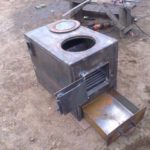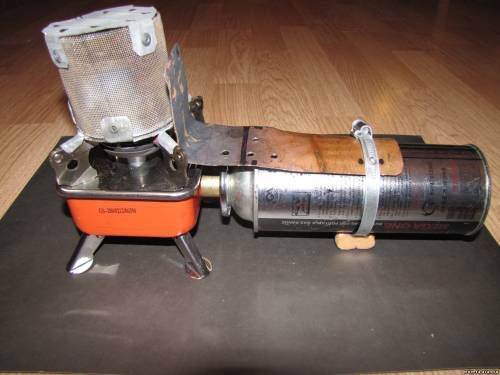A single-circuit boiler heats up, but the batteries do not heat up
The boiler is the main device in the heating system. It is used to transfer the generated thermal energy to the coolant. All boilers operate on the same principle.
The automation built into the boiler, using sensors and thermostats, determines at what point it needs to turn on in order to maintain the set temperature. Water is heated in a heat exchanger thanks to a pump that forces water to circulate throughout the heating system circuit. Boilers are manufactured as single-circuit and double-circuit. Single-circuit ones have only one circuit designed for heating.
In double-circuit systems there are two circuits - one circuit for heating, and the second for heating water. A distinctive feature of a double-circuit boiler is that two circuits cannot operate simultaneously; the boiler can either heat the room or heat water for domestic needs.
Boilers are available: floor-mounted and wall-mounted.
REFERENCE: Floor-standing boilers are produced only as single-circuit ones. If there is a need to heat water, you will have to purchase a storage boiler.
Floor-standing boilers are larger in size compared to wall-mounted ones, but are less demanding in terms of operating conditions. Boilers operate on different energy sources: gas, coal, wood, fuel oil.
The most popular among users are gas boilers, due to the fact that they do not require time and effort to load fuel.Once you connect the boiler to the gas pipeline, you can use the heating to your satisfaction. The main thing is to correctly select the power of the boiler and the volume of water that it can heat in one hour.
The content of the article
Main boiler malfunctions
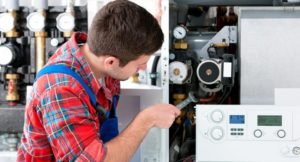 Gas boilers are reliable and durable, but like any equipment or machinery, they require maintenance and repair over time. All faults are classified into obvious and non-obvious. Some boiler models have a built-in fault detector.
Gas boilers are reliable and durable, but like any equipment or machinery, they require maintenance and repair over time. All faults are classified into obvious and non-obvious. Some boiler models have a built-in fault detector.
If the boiler is working and the batteries are cold, this may indicate that:
- Insufficient voltage in the network or a power surge due to which some parts may burn out;
- Insufficient natural gas pressure - less than 20 bar;
- The pressure in the heating system is less than 0.5 bar;
Unobvious boiler breakdowns:
- The most common is the failure of one of the main spare parts of the boiler: heat exchanger, thermostat, pump;
- The flow sensor is faulty;
- Gas valve problems;
- Clogged filters;
- Open circuit of the sensor in the boiler thermostat.
A specialist from a boiler service center who has experience, sufficient knowledge and special equipment to diagnose the malfunction will help identify a non-obvious breakdown.
Heating circuit problem
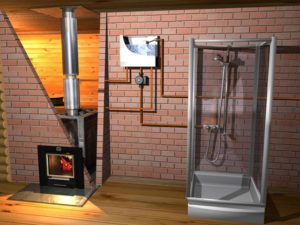 Sometimes people complain that the boiler turns on and works, but the water in the radiators remains cold or slightly warm.The main cause of the malfunction is incorrect setting or malfunction of the main parts: heat exchanger, pump or three-way valve.
Sometimes people complain that the boiler turns on and works, but the water in the radiators remains cold or slightly warm.The main cause of the malfunction is incorrect setting or malfunction of the main parts: heat exchanger, pump or three-way valve.
Of all the boiler problems, the most common malfunction is the formation of deposits in the heat exchanger. This occurs due to the use of hard tap water, like in a kettle where water is boiled. The heat exchanger in the boiler serves to transfer the heat it received during the combustion of energy carriers to cold water in the heating system, which passes through it.
The scale, having formed, does not allow the water to come into contact with the metal tubes and, passing through the heat exchanger with the scale, does not have time to warm up. To remove scale, they produce special liquid products that eliminate it, with which it is necessary to rinse the heat exchanger.
A single-circuit boiler heats up, but the radiators do not heat up due to the fact that a part such as a pump, which is supposed to pump hot water through the radiators, often fails. The reason for the incorrect operation of the pump may lie in the rotor, which could be jammed, or in the accumulation of air.
How to repair the system
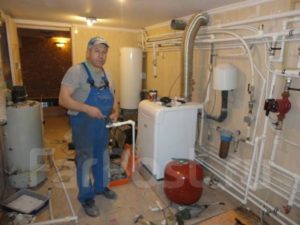 Initially, to determine whether the pump is faulty, you should check the operation of the rotor; to do this, you need to unscrew the plug nut at the end of the pump. When unscrewing, a small amount of water will flow out. Next, you need to insert a screwdriver inside and turn the pump shaft.
Initially, to determine whether the pump is faulty, you should check the operation of the rotor; to do this, you need to unscrew the plug nut at the end of the pump. When unscrewing, a small amount of water will flow out. Next, you need to insert a screwdriver inside and turn the pump shaft.
If air has accumulated in the pump, open the air vent and bleed it. The air vent looks like a cap that rises up and rotates around an axis. At the moment of descent, a certain hissing sound will be heard, as if you deflate a balloon.If all these manipulations do not help, you will have to replace the faulty part with a new one. Since repairs are quite difficult to perform, and the service is not cheap.
Important: If you do not have enough qualifications in boiler repair, it is better to invite a specialist from the service department. Since incorrect actions during your repair process can cause even greater damage to the boiler. And in the case of gas boilers, this is also life-threatening.
Advice from professionals: how to prevent problems from occurring
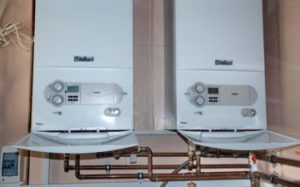 A gas boiler can last a long time without breakdowns if preventative maintenance is carried out in a timely manner. The most vulnerable part in boilers is the heat exchanger; due to the use of tap water, it needs regular cleaning. But not only the heat exchanger needs to be flushed, but also the heating system with radiators.
A gas boiler can last a long time without breakdowns if preventative maintenance is carried out in a timely manner. The most vulnerable part in boilers is the heat exchanger; due to the use of tap water, it needs regular cleaning. But not only the heat exchanger needs to be flushed, but also the heating system with radiators.
Experts recommend flushing the heating system with the following frequency:
- If antifreeze is used as a coolant, once every five years will be sufficient;
- If water is used as a coolant, it will need to be flushed once every ten years. Provided that water is not periodically added to the heating system;
- Preventative work should be carried out in the summer.


